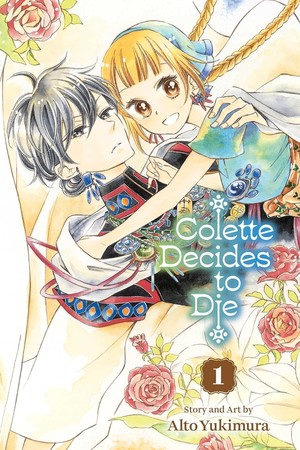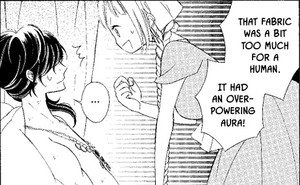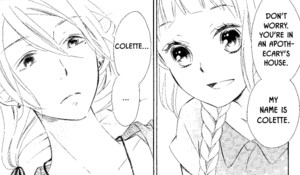The Fall 2024 Manga Guide
Colette Decides to Die
What's It About?

When exhausted workaholic apothecary Colette jumps into a well, instead of dying she finds herself caring for a new patient: Hades, Lord of the Dead. As Colette goes back and forth between her world and the underworld, new patients of every kind arrive daily!
Colette meets Hades, a fellow workaholic, while he is ill in bed with a rash and fever. After treating his condition, she learns about the work he does and what drives him, in turn renewing her sense of purpose as an apothecary. Colette is sent back to her own world, but is this the last she will see of Hades?
Colette Decides to Die has a story and art by Alto Yukimura, with English translation by Max Greenway. This volume was lettered by Inori Fukuda Trant. Published by Viz Media (November 5, 2024).
Is It Worth Reading?

Rebecca Silverman
Rating:
Despite its title, Colette Decides to Die is neither about suicide nor set in France. It's set in a version of Ancient Greece, and Colette doesn't so much “decide” to die as she gets run down and doesn't stop herself from falling into a well, which leads her to the underworld. (Very much still alive, I'll add.) She meets Hades, who is suffering from a rash, and being an apothecary, Colette sets out to heal him, thus beginning a relationship with the gods and Greek mythology that the title does nothing to indicate. Creator Alto Yukimura is, at least, aware of this; she mentions that the series went from one shot to limited series to its current long-running format, and by the time the story changed on her, it was too late to change the title. If the title put you off picking this up, rest assured that it has little to do with the actual plot.
And that plot is good. It's a deceptively quiet exploration of what it means to live and die, wrapped up in light Greek mythology with bonus world mythology elements, such as wells leading to the land of the dead. Colette falls somewhere between Shirayuki (Snow White with the Red Hair) and Maomao (The Apothecary Diaries) in terms of apothecary heroines: she's determined and strong-willed, but she also tries not to be abrasive even as she's utterly invested in caring for her patients. Hades, who has developed an allergy to the sun after spending so much time in the underworld, quickly learns that getting rid of the pesky human won't be as easy as he might like, but of course, he comes to feel like maybe that's not such a bad thing. Colette has a facility with the denizens of Hades' realm that (if I may be forgiven for throwing yet another reference in here) reminds me of Syalis in Sleepy Princess in the Demon Castle – they try to resist her, but ultimately become her friends and allies.
Of course, the very nature of this story means that it has to be at least a little bittersweet. The storyline where Colette discovers that her mentor, Anno, has died and is struggling with Hades' verdict of his virtuous soul is heart-wrenching, both because Colette must come to terms with Anno's loss and because it deals with the way we view our actions and how they stick with us. Shades in Hades' domain slowly revert to a childlike state, losing their memories before they return to the human world to be reborn, and that informs both Hades' character and the way Colette interacts with the underworld. It's beautiful but sorrowful at the same time.
The art is typical of Hana to Yume series, with clean, simple character designs with busy backgrounds and clothing. It works, even if it doesn't exactly scream “Greek mythology,” but then someone decided that it was fine to use the name Hercules instead of the Greek Heracles when all of the other mythological names are Greek, so there's that. Overall, this is very enjoyable, and the decision to publish it in ten two-volume omnibuses rather than twenty single volumes means that there's more to enjoy each time a new book comes out. I know I'll be happy to keep reading.

Caitlin Moore
Rating:
If I listen carefully, I can hear Rebecca screaming with helpless rage about Colette Decides to Die using the Greek pantheon but including Hercules instead of Heracles, on the other side of the country. Oh Disney, what hell hath you wrought on the classicists and folklorists of the world?
Mixing of mythologies aside, Colette Decides to Die was one of my top-anticipated releases of the fall and it did not disappoint. This shoujo series ran for eight years in Hana to Yume, home of many of my favorite shoujo series, including Fruits Basket and Yona of the Dawn. It also has features I look for in my teen girl romance, including a strong-willed heroine, fey men in semi-historical costumes, and a broader world focus than romance… though romance is still part of it.
It all begins when Colette, an apothecary suffering from terrible burnout, jumps into a well rumored to be connected to the underworld. Some minions spot her and pull her in to treat an unexpected patient: Hades, the god of the underworld, who had a bad reaction to sunlight and is covered in a terrible rash. Colette agrees to treat him. After an encounter with a shade she cared for in life years ago, discovers a renewed vigor for her profession. It's the kind of series I'd happily hand to a teenage girl, full of life lessons about self-care, compassion, and finding your way in the world. It's a touch didactic for an ancient thirty-something like me (practically a crone!), but perfect for a young woman figuring out how to live.
Plus, it's gorgeous! The setting is only loosely inspired by Greek mythology, and Colette's garb and village read more Central/Eastern European than the Mediterranean. Artist Alto Yukimura enjoys designing Hades' heavily jeweled and embroidered garb. There's also a distinct sensuousness to how she draws him and his interactions with Colette as she breaks through his brooding with her sunny disposition. It's a nice read, and this double volume is worth a purchase.
discuss this in the forum (25 posts) |
back to The Fall 2024 Manga Guide
Seasonal homepage / archives